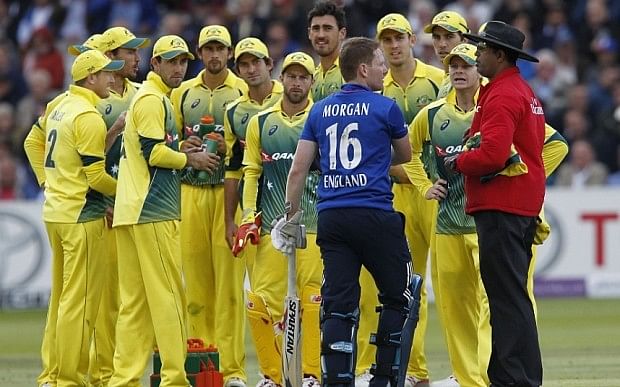
Obstruction at Lord's - Umpiring with eyes wide shut

Like conjoined twins, Australia and controversy share an inseparable bond. On field felonies are an integral part of their modus operandi. Encompassed by the notion that winning is not everything but in fact the only thing worth playing for, Australian teams of the yore have frequently tested the boundaries of gamesmanship to an unprecedented level.
An indelible illustration from history is Greg Chappell's decision to ask his brother Trevor to bowl underarm in a match against New Zealand. The incident marred Chappell's captaincy stint. Mind you, it wasn't unlawful, yet he faces public rancour even years into retirement.
Or Michael Clarke's vehement refusal to walk when he edged a ball to first slip against India in 2008. Or Brad Haddin claiming the dismissal of Neil Broom when it was clear that the batsman hadn't been bowled but in fact, the bails had been disturbed by Haddin's own gloves. In Clarke's case, justice could said to have been served at the hands of Stuart Broad in 2013.
Hiding behind the escape clause of an ambiguous law, Australian players were quick to rationalise their conduct at Lord's during the second One-Day International against England. However, chances are that they wouldn't have been quite as smug had they got the rough end of the pineapple. Anyone remember a grumpy Ponting gesturing crudely to the English dressing room after he was run out by a more agile substitute in Gary Pratt, at Trent Bridge?
‘It’s just not cricket’
Bill Woodfull had famously denounced England's body line tactics as anti-cricket or 'its just not cricket'. There was nothing indictable about England's methods, but fairness in sport isn't always covered under the blanket of laws, it requires a human touch from time to time. Although minuscule in magnitude, one could imagine his ghost frowning down upon the events at Lord's.
But Why Australia's inherent lack of civility should come to the fore in an inconsequential ODI series against England is slightly bemusing. After all, it was just another ODI, which would have been lost in the din of International cricket in two days time. A match otherwise devoid of context, eventually had a dramatic narrative, and is likely to be a dinner table talking point for a while.
A plausible explanation for Australia's misdemeanour is that Steve Smith wants to be seen as a quintessential Australian skipper. He can't be seen acting squeamishly. Perhaps, his desperation to revive the Australian spirit after the Ashes loss clouded his judgement. He was devoured by acrimony to a point that he forgot the sport's incorrigible knack of humbling its subjects.
If he captains Australia long enough, his indiscretion may return to haunt him like a malevolent power. He may come to rue his decision to uphold the appeal against Ben Stokes. The noose could be around his neck next time, and other teams will remember what happened at Lord's.
Mechanical officiating
What transpired at Lord's wasn't technically incorrect. The umpire can't technically be faulted for ruling Stokes out obstructing the field. The decision was technically cohesive with the law. The Aussies were well within their rights to appeal. The third umpire read the rule book as gospel.
However, it highlighted the mechanical functioning of a game played and officiated by humans. Anybody with a drop of human blood running through his veins, should have had no difficulty in gauging that it was an innate survival instinct that caused Stokes to put his hand out at the ball, as he instinctively turned to make his ground.
Those who have experienced a ball hurled at them, as if the sole purpose of its ephemeral existence was to kill, should have been more empathetic, even in the heat of the battle. Ruling Stokes out on the presupposition that he was trying to protect his wicket or worse, that he acted intentionally, knowing fully well that the ball was going to miss knocking his head off by a whisker, is preposterous and simply beyond the pale.
And if that wasn't the premise for the decision, then why did the law apply when it was crystal clear that his actions were inadvertent and beyond reasonable doubt only in defence of imminent physical danger?
Problems of slow motion replays
A bottomless law rendered the umpiring weak or was the converse the case? The use of technology was so poor that it illustrated the bankruptcy of the minds in charge of interpretation of an open-ended ruling. The on-field umpires, to their credit, reckoned that Stokes wasn't out. That was a real-time judgement.
The slow-mo replays, however, distorted the truth. The luxury of replays proved to be rather inconvenient. When the action was slowed down it created an illusion that Stokes couldn't have been in danger of being hit since the ball would have missed him by about six inches. But, how could the fact that the ball was thrown from a mere 10 yards away be so blatantly ignored? Why wasn't there a consideration that everything happened far too quickly for Stokes to ascertain that he wasn't quite in the firing line?
How many times have we seen batsmen lose track of their off stump or misread the line of a ball bowled from the full 22 yards? The aforementioned rhetoric explains why the provision of protecting oneself from injury should have applied in the curious case of Stokes. It reiterates that he couldn't have possibly known that the throw wasn't in line with his body.
Another fledgling question pertains to a fast bowler chucking the ball at the batsman in anger. How often is it done with the intent to run a batsman out? Moreover, Starc's appeal was as unconvincing as the idea that BCCI is a charitable organisation working tirelessly towards the development of associate nations. It was half-hearted, almost an afterthought, another imponderable that the third umpire should have taken note of before banishing Stokes back to the pavilion.